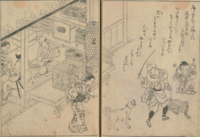Convener(s): Professor Sho Konishi and Dr Mateja Kovacic
Speaker(s): Dr Margarita Winkel, Coordinator, Institute of Area Studies, Leiden University
Margarita Winkel is a lecturer at the Leiden University Institute for Area Studies (LIAS). Her fields of interest include early modern Japanese society, in particular mass media and material culture as means of communication, and anthropological perspectives on contemporary Japan. Past research projects focused on early modern Japanese antiquarianism, and ethnographic studies by early Japanese explorers. Her current research interest is in human-animal relationships in Japan, past and present.
Abstract:
"How to get, keep, and breed your pet: exploring human-pet relationships through Tokugawa animal guidebooks"
Pet keeping in Japan did not start with modern society or the more affluent social classes. A contemporary source indicates that cats, for example, were kept as pets - meaning here that they were confined and embellished - in commoner households since probably the middle ages. In early modern Japan, in a society with a well-developed commercial publishing culture and an elaborate consumer culture, a wide range of sources reveal pet keeping practices. Taking pet manuals as a starting point - in the 17th and 18th century they were published for birds, goldfish, and rats, for example - this presentation discusses human-pet relationships in Japan’s early modern society relying on texts and images in popular prints and books, as well as in manuscripts.

絵本徒然草 – Ehon Tsurezuregusa, published in 1740, ill. Nishikawa Sukenobu Source: National Diet Library, Japan